Releases from two cult Californian producers have taken centre stage this week so far – see the analysis below.
Vérité 2017s
The 2017 vintage of the Vérité trio – La Muse, Le Désir, and La Joie – was released on Monday, at £320 per bottle each (in-bond). The latest releases have picked up much praise from critics, and mark an historic year for the estate – completing its harvest one week before the arrival of North California’s devastating Tubbs Fire, Vérité’s vineyards escaped unscathed, and their grapes picked before any smoke taint from neighbouring areas could set in. This also marks the first collective release of Vérité’s flagship wines in an assorted case, with previous vintages available to purchase separately.
Comprising 100% Merlot grapes for the first time since its conception, La Muse 2017 receives 96 points from Wine Lister partner critic, Antonio Galloni. He notes that the vintage “is aromatically deep, beautifully persistent and just impeccable in its balance”, stating that he “liked it more than the 2016”. A price of £320 places the 2017 20% below the current market price of the 2016, which has risen over 30% in price since its release, and has limited remaining market availability.
Le Désir 2017 obtains 98 points from Galloni – its highest ever score from the critic. He states it is “off the charts fabulous”, and describes notes of “mocha, chocolate, licorice, leather, menthol, pine and spice”. Akin to La Muse, market availability of last year’s release is scarce, illustrating its good track record of selling through post-release. Keeping in mind the 2017’s record-breaking score, it will be interesting to see if this trend continues this year, given the collective format in which the wines are being sold.
La Joie 2017 breaks the same record as its sibling, Le Désir, receiving its highest score to date from Galloni (96). He calls it “another gorgeous wine in this lineup”, describing “hints of rose petal, lavender, mint and blood orange”, and concluding that it is “a stunning wine by any measure”.
Joseph Phelps
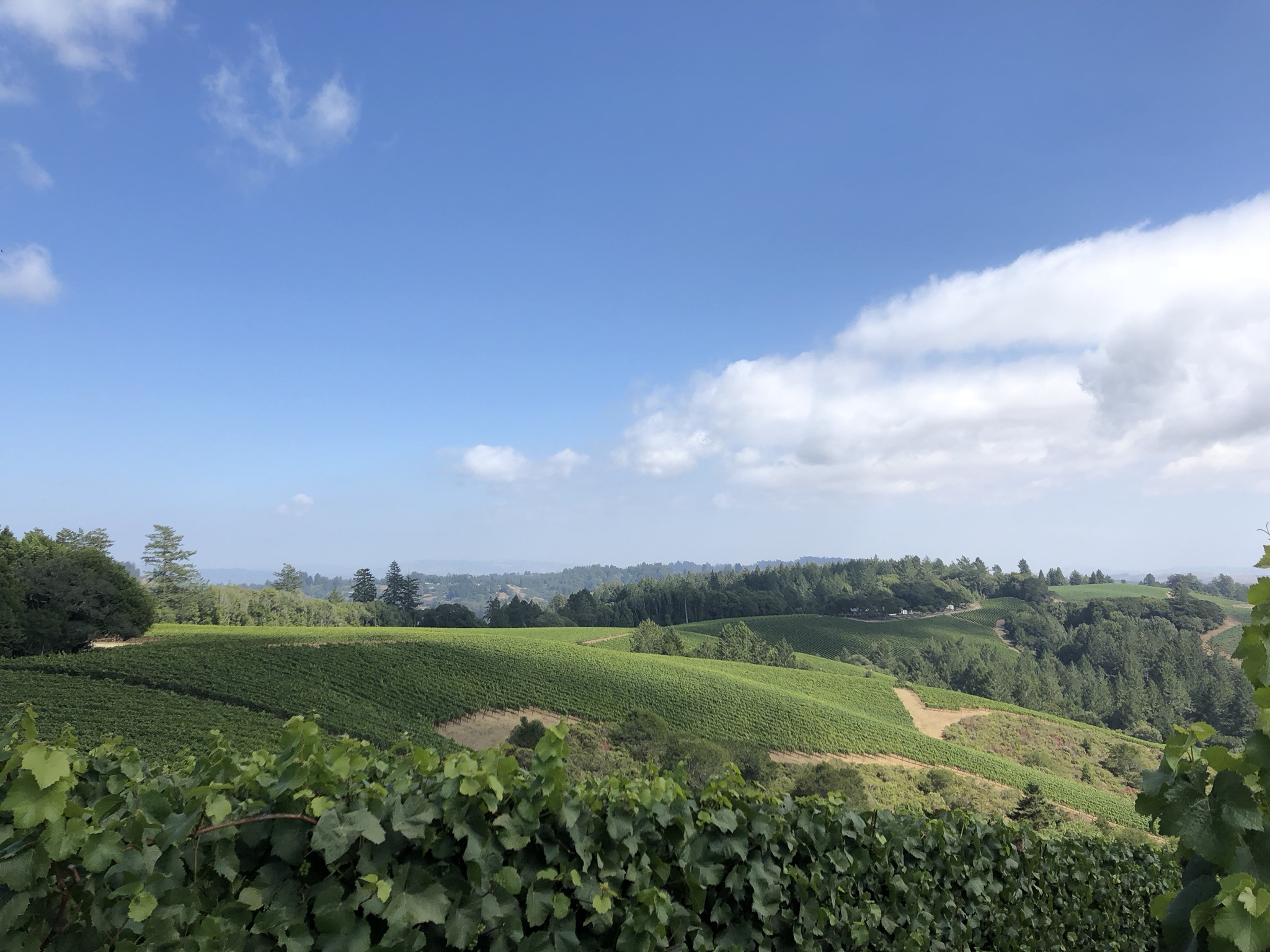 Joseph Phelps’ Napa Valley vineyards – which saw their hottest recorded temperatures in 2017
Joseph Phelps’ Napa Valley vineyards – which saw their hottest recorded temperatures in 2017
Insignia 2017 entered the market yesterday at £160 per bottle in-bond (flat on the 2016 release price). As we were told in a recent Zoom tasting with Phelps’ granddaughter and the winery’s Director of Business Development, Elizabeth Neuman, the 2017 vintage lives up to her vision of Insignia as “a tangible legacy of Joe himself – achieving the best of the best”. Neuman informed us of Winemaker, Ashley Hepworth’s recent dedication to achieving texture in the wine, through which she has experimented with blending trials prior to ageing.
Awarding Insignia 2017 91-94 points, Galloni indeed describes a “dark, sumptuous and enveloping feel, with a real sense of breadth and textural resonance”, adding that “more than anything else, the 2017 is all about palate richness”. Wine Lister likewise recognised the finessed texture of the vintage, with Wine Lister CEO, Ella Lister, calling it “supple, gentle, and silky” on the palate, complete with “dark fruit, plum, and chocolate” on the nose.
Frequent heatwaves in 2017 saw record-high temperatures reached throughout the growing season, including an instance of 46.7°C, recorded in Phelps’ Saint Helena Ranch during Labor Day weekend. The 2017 vintage is consequentially the winery’s smallest in 20 years, with total production down 60% on the 2016. The significant reduction in the volume released this year, as well as the estate’s developing style, may work to encourage interest.
Also released over the past two days: Orma 2018, Petrolo Galatrona 2018, and Siepi 2018.
Sign up to Wine Lister’s free subscription to get market insights delivered straight to your inbox: https://wine-lister.com/subscribe/info.
Sampled by the Wine Lister team at last week’s CVBG Beyond Bordeaux tasting, the latest Place de Bordeaux releases cover a range of regions and price points. Below we examine some of the highlights:
Wednesday 9th September
Released at c.£225 per bottle (in-bond), Beaucastel Hommage à Jacques Perrin 2018 enters the market below the current prices of the two previous vintages (see graph below). Hommage was a Wine Lister favourite this year. We detected bright, candied strawberries, orange skin, and clove, while its mouthfeel offered a momentary grip of tannins, followed by a silky-smooth finish.
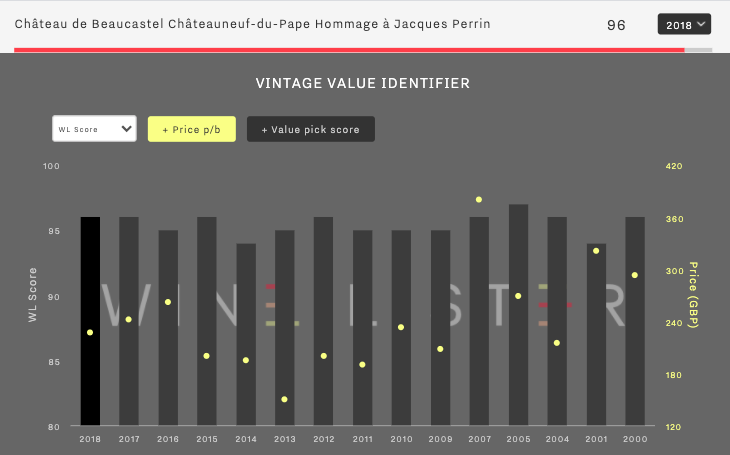
With a 15% reduction in volume released this year, alongside the château’s unwavering reputation for producing benchmark quality in Châteauneuf-du-Pape, the new vintage is worth considering for future drinking. In the meantime, back vintages 2015, 2012, and 2009 also look good in terms of price and quality. Writing for JancisRobinson.com, Tom Parker MW awards the 2018 17+ points, noting “meaty, earthy fruit on the nose, very complex already”, and “damson and morello cherry” on the palette.
Inglenook Rubicon 2017 also entered the market on Wednesday at £120 per bottle (in-bond). Produced by the estate since 1978, the flagship wine has maintained a score of 95 or above from Wine Lister partner critic, Antonio Galloni, over the past five vintages, and the latest release is no exception. Awarding it 95 points, he describes notes of “red fruit, cedar, sweet pipe tobacco, menthol and licorice” that “all develop in the glass”. Our team detected complex spice and oak, softened by a gentle hint of vanilla.
Thursday 10th September
Released yesterday at £54 per bottle (in-bond), Cheval des Andes 2017 receives 17.5+ points from Tom Parker MW for JancisRobinson.com. He describes “intense and expansive black fruit and spices on the nose, with a hint of black olive and violet”, and “blueberry, violet and dried herbs” on the palette. He concludes, “I expect this to become even more impressive after 5 years in bottle, though you could drink it sooner”. Having tasted a flight of recent back vintages at the time of last year’s release with Technical Director, Gérald Gabillet, the Wine Lister team can attest to Cheval des Andes‘ continued upward quality trajectory. We noted a definite complexity within the latest vintage, which offers a nose of Parma violets, white pepper, and bright berries. Cheval des Andes 2017 enters the market under current prices of the last three vintages, and is worth snapping up if there remains any availability.
Solaia 2017 completes the quartet of releases from the past couple of days. Matching last year’s release price of £175 per bottle (in-bond), the latest vintage comes onto the market comfortably under current prices of the previous two (which have increased their respective values by c.20% since release – see chart below). Wine Lister partner critic, Antonio Galloni, awards Solaia 2017 95+ points, and describes “terrific aromatic expansiveness and tons of persistence”. There is anticipation for this score to improve: “I can’t wait to taste it with a bit more time in bottle”, he adds. We tasted the 2017 last week, and were indeed impressed with its development, finding an elegant nose of violet drops and cocoa powder. Given its impressive quality in such a challenging year, and the wine’s history of good price performance post-release, this is well worth securing now.
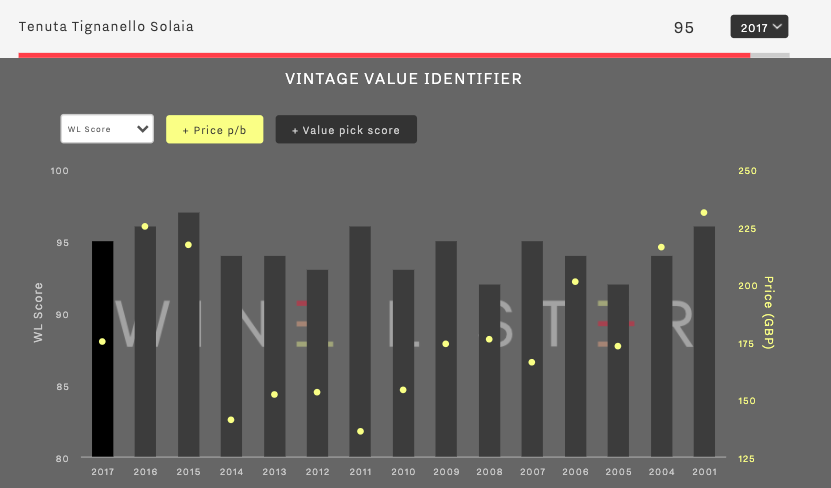
Among other benefits available exclusively to the trade, Wine Lister’s Pro+ Subscription offers real-time release alerts and live analysis on major wine releases throughout the vinous calendar. Please email us at team@wine-lister.com to enquire.
The last two days of Place de Bordeaux releases have included vintages from three powerhouse producers of different regions, whose commonality lies in their use of Bordeaux varietals. Below we examine these key releases.
Monday 7th September
The second week of September Place de Bordeaux releases began with the latest offerings from cult Californian producer, Opus One. Described by Wine Lister partner critic, Antonio Galloni, as “one of the most complete wines of the vintage”, 2017 Opus One was released onto the UK market at £228 per bottle – the same price as the 2016. Awarding it 95+ points, he states that the 2017 is “a dense, full-throttle beauty”, with “a distinctly red-toned fruit profile that distinguishes it from the surrounding vintages”. Although receiving one point less than the 2016 (which has a score of 96+ from Galloni), the latest vintage holds particular significance. 91% of fruit had been picked just before the devastating Californian wildfires commenced, eradicating two lots of Opus One vines. Awarding 17.5 points to the 2017, Wine Lister partner critic, Jancis Robinson, notes that there is “not a trace of smoke taint”, and describes “a combination of savoury and something as sweet and chalky as Edinburgh rock”.
Both the historic nature of the vintage, and the reduction in volume released this year are facts sure to encourage high levels of interest. Opus One is, perhaps unsurprisingly, the number one US wine (and joint-fifth overall) voted by the trade to have seen the sharpest rise in demand, as shown below:
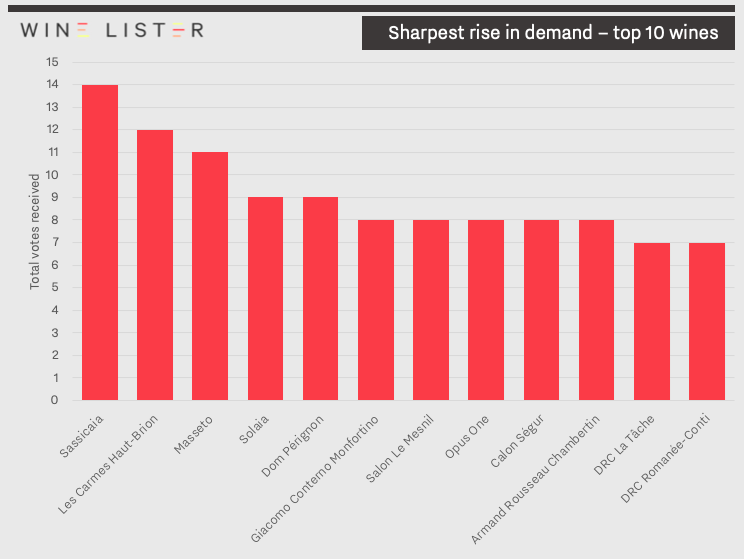 Results from Wine Lister’s 2019 Founding Members survey, showing the consensus on the top 10 wines that have seen the sharpest rise in demand
Results from Wine Lister’s 2019 Founding Members survey, showing the consensus on the top 10 wines that have seen the sharpest rise in demand
Tuesday 8th September
Kicking off yesterday’s releases, Masseto 2017 was released, and merchants were offering at around £480 per bottle. Though slightly higher than last year’s first tranche release price (readers should note that this year, there is only one single tranche), the 2017 enters the market 11% below the current price of the 2016. Antonio Galloni gives the 2017 96-99 points (up from 94-97 for the 2016), calling it a “spectacular wine in the making”, with notes of “red cherry jam, mocha, leather, licorice and a dash of new oak”. While 2017 will be remembered as one of the hottest and driest growing seasons in recent history, Winemaker, Axel Heinz, states that the vintage “managed to encapsulate all the ripeness and concentration” of the climatic conditions. Indeed, Galloni notes that the latest release is “quite simply a remarkable wine for such a challenging year”. Masseto already earns strong acclaim as the wine to have seen the third-sharpest rise in demand according to the trade (see above) – the 15% reduction in volume released onto the market from last year will no doubt only encourage requests for the 2017 further.
The second wine from the cult producer, Massetino 2018 was also released yesterday, at a likely UK market price of c.£205 per bottle. Although its second vintage, this is the first international release of Massetino, as last year’s distribution was limited to the Italian and the US markets only. We sampled the latest release at CVBG’s Beyond Bordeaux tasting, and found it to have expressive, concentrated fruit on the nose, and more refined notes of Marcello cherry and minerality on the palette.
Yesterday’s releases ended with a bang, as Latour released its 2009 vintage. Merchants offering at c.£860 per bottle place the 2009 just under the current market price of the iconic 2010. This is the first ex-château stock to be released since its original en primeur release, and is available at a c.10% premium to existing stock on the market. Wine Lister partner critic, Neal Martin, awards the latest release 99 points, stating that it “is endowed with a simply magnificent nose with intense blackberry and cassis fruit laced with minerals and graphite, extremely focused to the point of overwhelming the sense”. “Wow”, he concludes.
Among other benefits available exclusively to the trade, Wine Lister’s Pro+ Subscription offers real-time release alerts and live analysis on major wine releases throughout the vinous calendar. Please email us at team@wine-lister.com to enquire.
The Place de Bordeaux September releases commenced this week (Tuesday 1st September), launching the distribution of several New World (and a few Old World) icons through its impressive network. The releases have so far exhibited high praise from critics. This affirms the increasing appeal of New World wines, despite the current economic crisis making for an unlucky welcome.
Choices from Chile
Clos Apalta opened the stage on Tuesday, with a vintage that marks its 20th anniversary, as honoured by the 2017’s commemorative bottle. Receiving 100 points from James Suckling, and 95 points from Luis Gutiérrez for Wine Advocate, its average critics’ score of 97.5 matches both the 2016 and 2015 vintages. We sampled it at this week’s Bordeaux and Beyond tasting, organised by négociant CVBG, and found notes of bright red fruit, spice, and orange peel. Despite being one of the most expensive recent vintages (joint with 2016) at £74.50 per bottle (in-bond), Clos Apalta has no doubt achieved a high quality for this anniversary bottle.
Another Chilean entry, Almaviva 2018 was released at £101.00 per bottle (in-bond) on Wednesday (2nd September) – c.4% down on last year. Its average critics’ score of 97 points places it in line with 2017 as the joint-best average score to date, which, alongside its slight reduction in volume from last year, may stimulate demand. Indeed, we found the 2018 to be bright and energetic, with notes of ripe currants, green tomato, and spice.
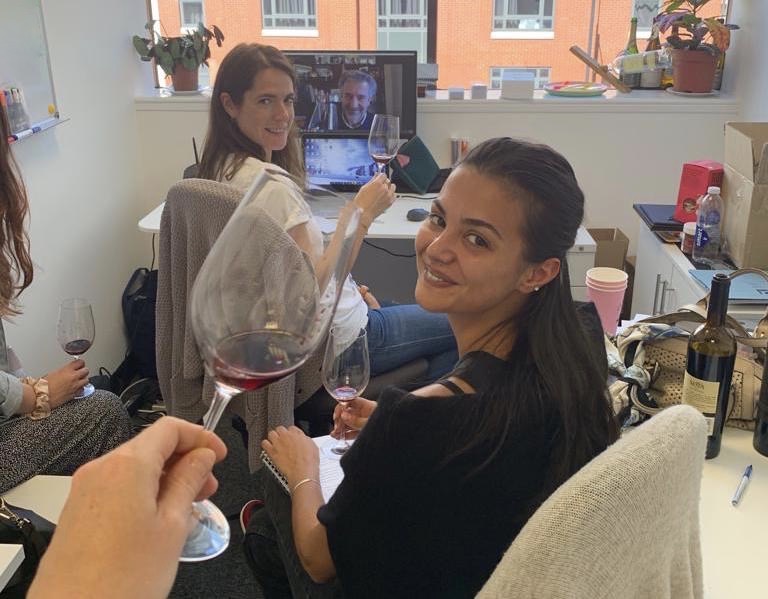 The Wine Lister team sample 2018s from Seña and Chadwick with Owner, Eduardo Chadwick, and his team
The Wine Lister team sample 2018s from Seña and Chadwick with Owner, Eduardo Chadwick, and his team
Released on Thursday (3rd September) at £82.50 per bottle (in-bond), Seña 2018 is “the best vintage of this decade”, according to Owner, Eduardo Chadwick. He explained to us that growing conditions in 2018 were balanced between the two previous vintages (2016 was very cool, while 2017 was hot and dry), creating “almost a perfect season”. The vintage receives 100 points from James Suckling, and 98 points from Luis Gutiérrez for Wine Advocate, making it Seña’s highest-ever average score from those two critics – 99. Our team was equally impressed in our virtual tasting, noting its velvet mouthfeel, silky tannins, and juicy freshness. Chadwick 2018 was also released this week (just 6000 bottles), acquiring an average critics’ score of 97.5 at £226.33 per bottle (in-bond).
Introducing Italy
Bibi Graetz Testamatta 2018 and Bibi Graetz Colore 2018 entered the market on Tuesday (1st September), at £70 and £180 per bottle (in-bond), respectively. Both wines offer significant discounts from their previous releases, and have achieved praise from critics. James Suckling gives 97 points to Testamatta 2018, describing a “cherry and lemon rind character”, and “fine tannins”, and 100 points to Colore 2018, calling it “one of the best vintages ever produced. The high quality and suitable pricing of both wines will likely be embraced in the present economic climate.
An Australian addition
Jim Barry The Armagh Shiraz 2016 entered the market on Wednesday, at c.£151 per bottle (in-bond), marking the producer’s inaugural release through La Place de Bordeaux. The vintage received 97 points from Wine Advocate’s Joe Czerwinski – the highest WA score received by The Armagh Shiraz since its 2012 vintage. He states that the 2016 is “full-bodied and supple” and “finishes cedary, intense and long, adding in complex, lingering spice notes”.
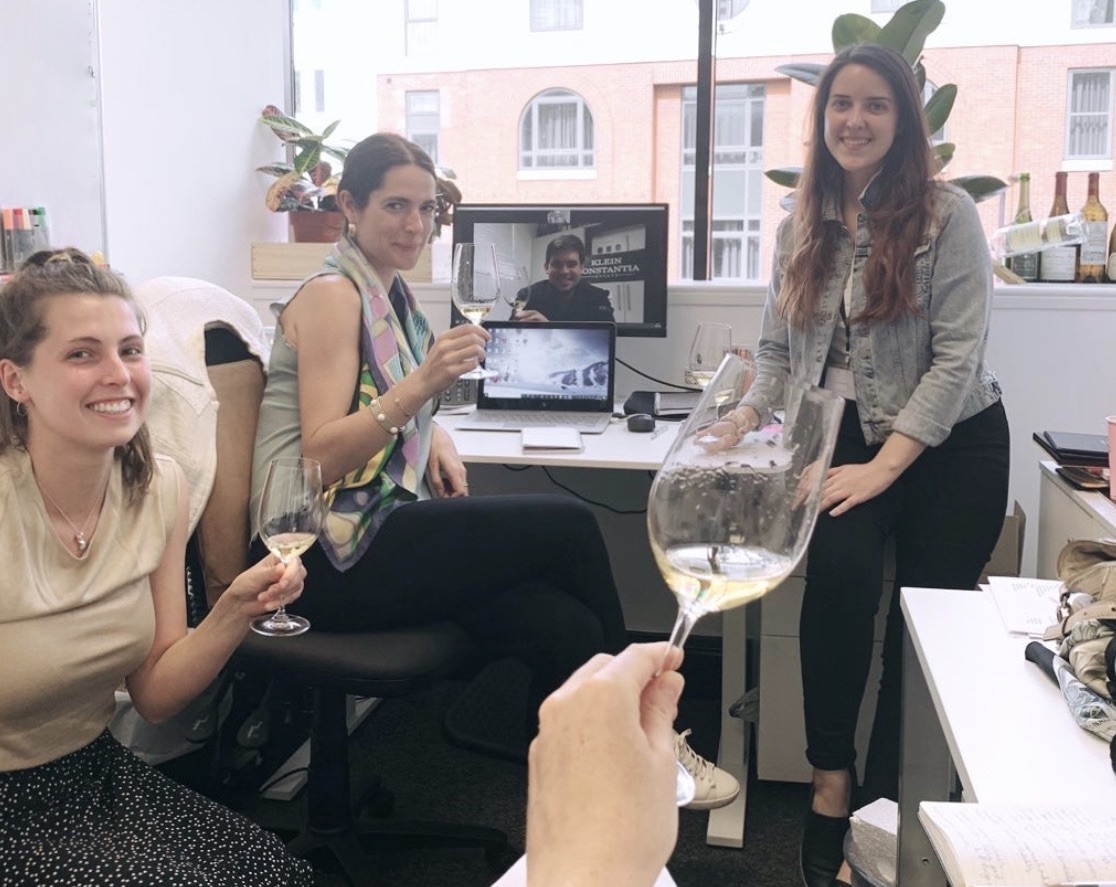 The Wine Lister team sample the 2017 Vin de Constance with Winemaker, Matt Day
The Wine Lister team sample the 2017 Vin de Constance with Winemaker, Matt Day
A sweeter offering from South Africa
As told to us by Winemaker, Matt Day, in a recent Zoom tasting, the 2017 Vin de Constance (released on Wednesday 2nd September) is the closest vintage yet to their philosophy of creating a “dry sweet wine”. Wine Lister’s CEO, Ella Lister, notes hints of “apricots, rosewater, lemon balm, Marcona almonds, and acacia honey” among other aromas, and on the palate “dried apricots and a gorgeous savoury finish”. At £39 per bottle (in-bond), the 2017 receives 97 points from James Suckling, compared to an average of 95 (from James Suckling and Wine Advocate) for each of the past three years. While it does not offer a discount, Klein Constantia does a spectacular job of achieving high quality in its developing style of Vin de Constance.
Kick-starting California
L’Aventure Estate Cuvée 2018 was released yesterday (Thursday 3rd September) at c.£68 per bottle (in-bond) – flat on the 2017 release price, and earning 95 points from Wine Advocate’s Erin Brooks (one down from the 2017). She noted that “the full-bodied palate is incredibly pixelated and silky with very bold freshness and a long, layered finish” and that she “can’t wait to taste this beauty from bottle”. We enjoyed detecting violet, toast, and vanilla on the nose, and were similarly impressed by its velvet mouthfeel.
Among other benefits available exclusively to the trade, Wine Lister’s Pro+ Subscription offers real-time release alerts and live analysis on major wine releases throughout the vinous calendar. Please email us at team@wine-lister.com to enquire.
With September approaching, Wine Lister has begun to anticipate the collection of top fine wine producers from around the world that release their latest vintages through the Place de Bordeaux. Although a region steeped in tradition, the trend for Bordeaux négociants to offer these wines in the first weeks of September suggests a loosening in the division between Old World and New World fine wine production.
To celebrate the impending campaign, this week’s blog examines a small selection of New World wines with longstanding histories:
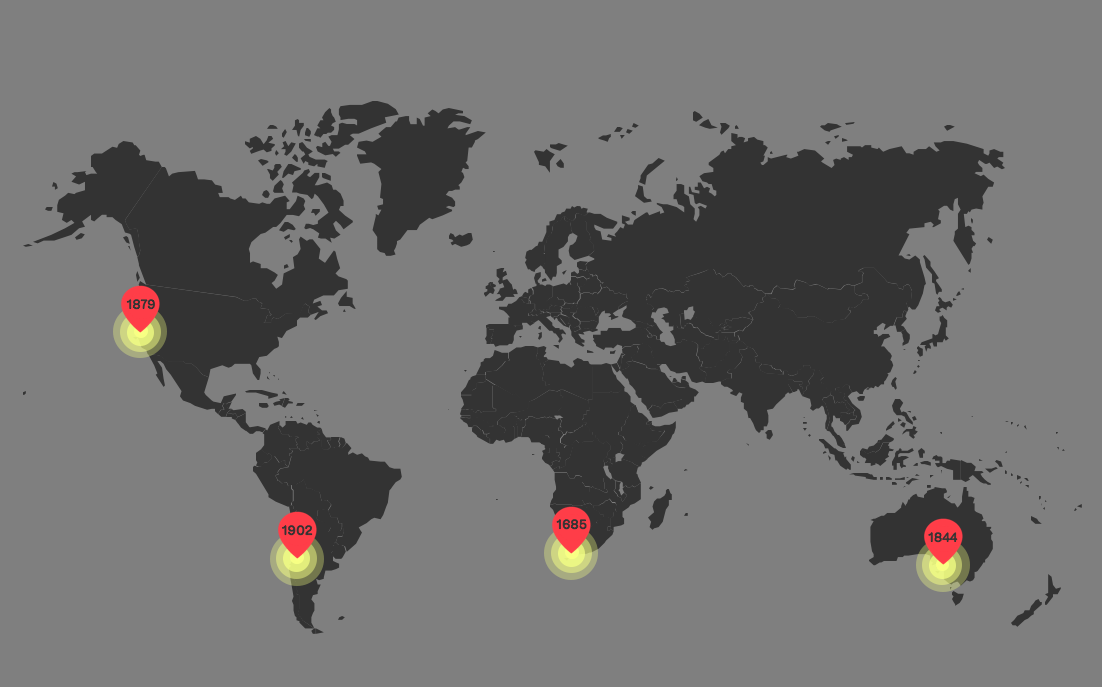 A map of the selected New World wineries: Klein Constantia, Penfolds, Inglenook, and Bodega Catena Zapata
A map of the selected New World wineries: Klein Constantia, Penfolds, Inglenook, and Bodega Catena Zapata
South Africa – Klein Constantia Vin de Constance
Established in 1685 by the first Governor of the Dutch Cape Colony, Simon van der Stel, Klein Constantia was the first commercial wine producer in South Africa. A keen viticulturist, Van der Stel executed extensive research to find the best quality soil in the region, finally deciding on the decomposed granite terroir of the valley he named “Constantia”. Here he planted the first Muscat de Frontignan vines, and commenced the production of Vin de Constance.
In more recent history, Klein Constantia has been elevated over the past decade under Managing Director, Hans Astrom, and Winemaker, Matt Day. Its cellar has been entirely rebuilt, and viticultural practices are now widely organic and biodynamic. The 2017 Vin de Constance is the third vintage produced in the new cellar and will be released through the Place de Bordeaux next month; however, until then, Vin de Constance 2013 achieves a WL score of 94 at c.£71 per bottle (in-bond). It can be purchased by the case of six half-litre bottles from Albany Vintners.
Australia – Penfolds Magill Estate Shiraz
Penfolds was founded by an English doctor, Christopher Penfold, and his wife, Mary, who had transported French vine cuttings on their journey from West Sussex to Australia. After acquiring 500 acres of land in the Adelaide foothills, they commenced production of medicinal tonics, brandies, and fortified wines in the style of sherry and port, to ameliorate the symptoms of Christopher’s patients. As demand for the wines proliferated, production was expanded, and Penfolds was officially established in 1844. The single-vineyard Magill Estate Shiraz is intrinsically linked to the winery’s beginnings, being the only wine grown and made on the original Penfolds property.
With a WL score of 95 at £88 per bottle (in-bond), the 2014 Penfolds Magill Estate Shiraz is a MUST BUY, and was described by Wine Lister partner critic, Jancis Robinson, as “racy and lively”, illustrating “a winemaking tour de force”. It is available to purchase by the case of six from IG Wines.
California – Inglenook Rubicon
Although vines had been planted on the property by its previous owner eight years prior, Napa Valley’s Inglenook estate was officially founded in 1879 by Gustave Niebaum, a Finnish sea captain, fur-trader, and oenophile. With the intention to build a winery to rival Europe’s finest, Niebaum swiftly invested in the development and expansion of Inglenook, purchasing additional land from six neighbours, and commencing construction on the present-day château. Rubicon, the estate’s flagship wine since 1978, is produced from the estate’s best fruit, including Gustave Niebaum’s original Cabernet Sauvignon plantings.
Rubicon typically contains small percentages of other Left Bank Bordeaux varietals, however, the quality of Cabernet Sauvignon in 2013 called for its pure varietal composition. According to Wine Lister partner critic, Antonio Galloni, the 2013 Inglenook Rubicon features “Layers of dark fruit built into a crescendo of aromas, flavors and textures laced with mocha, espresso, gravel and dark spice overtones”. Achieving a WL score of 96, and MUST BUY status, it can be bought by the bottle from Lay & Wheeler for £145.75 (in-bond).
Argentina – Bodega Catena Zapata Nicolás Catena Zapata
Bodega Catena Zapata was founded in 1902 by Italian immigrant Nicola Catena, who planted the initial Malbec vines to produce wine to satisfy the large European immigrant population in Mendoza. As examined in a recent blog post on New World MUST BUYs with rising popularity, Nicola’s grandson, Nicolás Catena Zapata, continued his grandfather’s legacy of establishing of European winemaking techniques in Argentina, through his dedication to high altitude farming, soil studies, and preserving pre-phylloxera Malbec strains.
Its 2017 vintage is due to release through the Place de Bordeaux next month; until then, the 2016 Nicolás Catena Zapata can be acquired by the case of six from Cru World Wine for £278 (in-bond). Comprising 61% Cabernet Sauvignon, 31% Malbec, and 8% Cabernet Franc, the 2016 achieves a WL score of 93, and was described by Jancis Robinson as “very broad, well integrated and welcoming”.
Keep up to date with the September Place de Bordeaux releases through Wine Lister’s twitter.
Wine Lister’s latest MUST BUY update identified 38 new wines that show quality and value within their respective vintages and appellations, and wide praise from the international trade. To help you discover these new picks, this week’s blog takes a deep dive into the latest MUST BUY wines and their geographical composition.
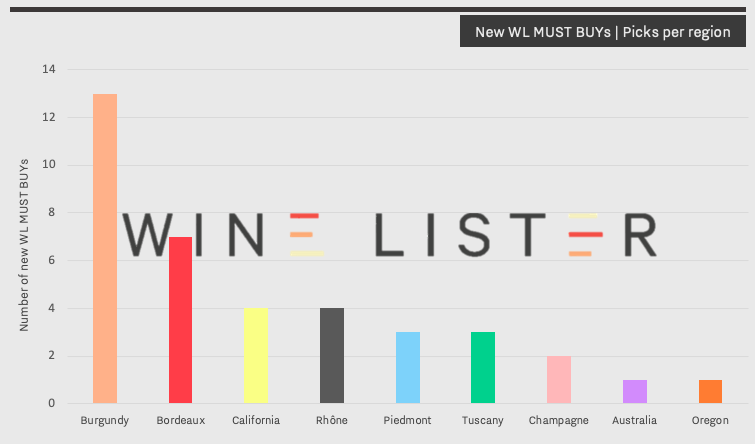
Pinot Noir picks
Burgundy dominates the new MUST BUY hoard with 13 entries, including eight reds. The perfect pick for an opulent occasion, the 1978 Romanée-Conti Richebourg costs £1,434 per bottle (in-bond), and was described by Wine Lister partner critic, Jancis Robinson, as “very long with smoothness, sweetness and unctuousness”. Sharing its WL score of 96, the 2010 Volnay Clos des Ducs from the Côte de Beaune’s red producer of reference, Marquis d’Angerville, provides a more affordable option at £250 per bottle (in-bond), but may merit a little patience.
Outside of Pinot Noir’s original homeland are some new MUST BUYs of brilliant quality and impressive value for money. California’s 2016 Au Bon Climat Isabelle Pinot Noir has a WL score of 94, and was described by Wine Lister partner critic, Antonio Galloni, as “racy, perfumed and beautifully layered”, with notes of “orange peel, tobacco, blood orange, spice, star anise and new oak” throughout. It can be purchased for less than five times the price of the aforementioned Volnay, by the case of six for £262 (in-bond) from Jeroboams.
Travelling north within the US brings us to Oregon’s latest MUST BUY entry – the 2016 Cristom Louise Vineyard Pinot Noir. While more expensive than its Californian counterpart for the same WL score, Cristom’s position as the leading producer in the Willamette Valley, alongside its closer proximity to Burgundy’s cool-climate restrained style, makes it more than worth the c.35% premium. It is available to purchase for c.£60 per bottle (in-bond) from WineBuyers.com.
The best of Bordeaux blends
Bordeaux offers seven new MUST BUYs this week, including two Left Bank Value picks; 2019 Haut-Bages Libéral and 2015 Capbern. With a WL score of 92, the former addition was released en primeur two months ago, and described by James Lawther for JancisRobinson.com as, “busy and expressive on the nose with vineyard-fresh dark fruit, black-olive and mineral notes”. Labelled by Lawther as the “best in recent years”, this gem from Bordeaux’s prominent promotors of biodynamic viticulture, Gonzague and Claire Lurton, has a bright future ahead. It can still be bought en primeur through Justerini & Brooks for £142.50 per six (in-bond).
The 2010 Vieux Château Certan also appears in the latest MUST BUY update, 10 years on from the iconic vintage. It provides a more lavish option for the Bordeaux buyer, receiving a WL score of 96 at £216 per bottle (in-bond). Moving across the border into Tuscany, the 2010 Sassicaia also offers a more luxurious alternative to the Bordeaux blend. Comprising of 85% Cabernet Sauvignon and 15% Cabernet Franc, it was described by Antonio Galloni as, “just beginning to show the first signs of aromatic development”, including hints of “sweet tobacco, mint, pine, dried cherries and licorice”. It achieves a WL score of 95, and is available to purchase by the case of six for £915 from Goedhuis & Co.
Choosing Chardonnay
Back to Burgundy, and the new white MUST BUYs this week offer opulence from three iconic Meursault producers; 2015 Roulot Charmes, 2010 Comtes Lafon Genevrières, and 2017 Arnaud Ente Les Petits Charrons are all exceptional choices, albeit for an average price of £492 per bottle (in-bond). Further north, two entries hail from Chablis, and the appellation’s original historic vineyard, Les Clos; 2014 Laroche Les Clos, and 2010 Christian Moreau Père et Fils Les Clos. For those who enjoy a more pure, lean, and mineral style of white wine, the Chablis MUST BUYs exhibit notable value within their appellation and achieve higher WL scores than their buttery Meursault counterparts. The latter can be bought by the case of 12 from Cru World Wine for £871 (in-bond).
California’s latest white MUST BUY hails from Kistler Vineyard; a cult producer known for its emulation of pure and balanced Burgundian Chardonnays, over the rich and oaky Californian style. The 2017 Kistler Vineyards Dutton Ranch Chardonnay achieves a WL score of 96, and is labelled by Antonio Galloni as “such an intriguing wine because of the way it is airy and lifted and yet also so deep in feel”. Providing a less expensive alternative to Côte d’Or whites, it is priced at £133 per bottle (in-bond).
Also featured in the list of new MUST BUYs are: 2009 Abreu Madrona Ranch Cabernet Sauvignon, 1989 Bollinger Grande Année, 1996 Bruno Clair Chambertin Clos de Bèze, 2006 Cavallotto Barolo Vignolo Riserva, 2013 Ceretto Barolo Brunate, 2012 Conti Costanti Brunello di Montalcino Riserva, 1996 Dunn Vineyards Howell Mountain Cabernet Sauvignon, 2014 Duroché Chambertin Clos de Bèze, 2017 Georges Mugneret-Gibourg Clos de Vougeot, 2012 Jacques-Frédéric Mugnier Chambolle-Musigny Les Amoureuses, 2014 Jean Grivot Richebourg, 2010 Jim Barry The Armagh Shiraz, 2017 Joseph Drouhin Chambolle-Musigny Les Amoureuses, 1996 Lafite Rothschild, 2008 Lafleur, 2016 Le Macchiole Paleo Rosso, 2016 l’Evangile, 2006 Louis Roederer Cristal Rosé, 2018 Marc Sorrel Hermitage, 2013 M. Chapoutier Hermitage Ermitage Blanc De l’Orée, 2016 M. Chapoutier Hermitage Ermitage Le Méal, 2012 Roagna Barbaresco Pajè Vecchie Viti, 2016 Valandraud, and 2009 Vincent Paris Cornas La Geynale.
Thanks to solid discounts on existing market prices from many châteaux, the Bordeaux 2019 en primeur campaign can be considered a success, and may prove in the long-term to have helped the en primeur system find its feet once again, in terms of the cost benefit it offers to buyers.
Part II of Wine Lister’s Bordeaux Study, In sickness, in health discusses this in more detail. In the meantime, below we have selected top MUST BUYs at different price points, to help those still on the hunt for Bordeaux 2019.
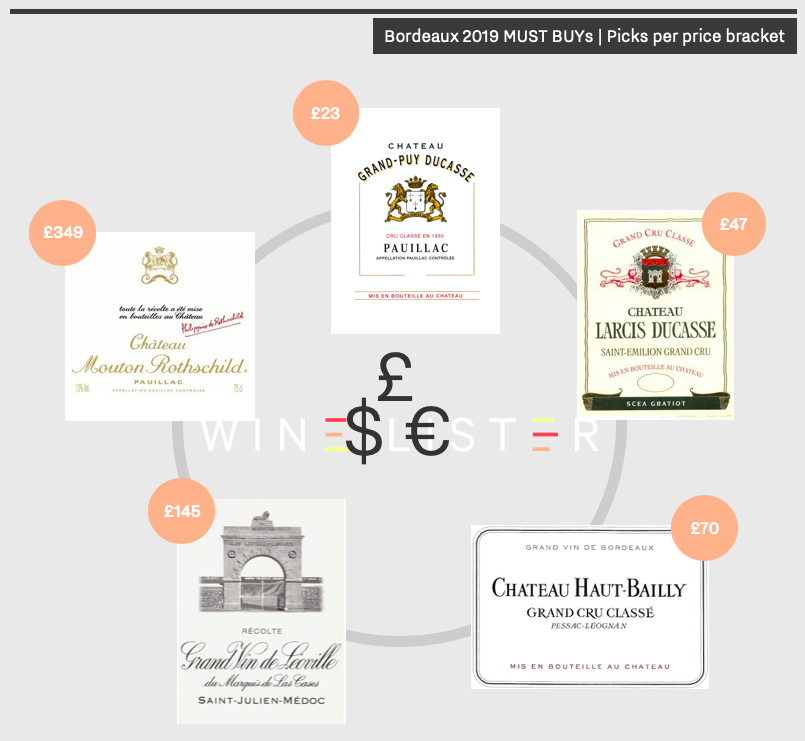
Under £25 – Grand-Puy-Ducasse
Grand-Puy-Ducasse 2019 is both a MUST BUY and a Value Pick, achieving its best ever WL score of 93 in 2019, available at £23 per bottle (in-bond) when buying by the case. The latest release illustrates the contrasting climatic conditions of 2019, with critics noting its complexity and nuance. Wine Lister partner critic, Neal Martin, notes, “crisp tannins, a fine bead of acidity, cohesive and harmonious with a lovely saline/briny note”, adding “this is one of the best Grand Puy Ducasse wines that I have encountered from barrel. Excellent”. Grand-Puy-Ducasse 2019 is available to purchase by the case from Justerini & Brooks.
More Bordeaux 2019 MUSY BUYs under £25: Capbern, Gloria, Laroque, Meyney, Potensac, and Siran.
Under £50 – Larcis-Ducasse
At £47 per bottle (in-bond), Larcis-Ducasse 2019 is priced notably well within the wider context of Saint-Émilion Grand Cru Classé “B” releases. As examined in a recent en primeur blog, it earns a WL score of 95 – just one point less than the likes of Cheval Blanc and Pavie (costing on average six times less than its Classés “A” neighbours). Winemaker, David Suire, observes that the vintage reflects clearly its limestone terroir, showing floral notes and an overriding minerality. Wine Lister partner critic, Antonio Galloni, concurs, noting “graphite, menthol, licorice, tobacco and cedar notes” in the bouquet, coining it “one of Bordeaux’s most under the radar gems”. While demand for this wine has likely been strong, Larcis-Ducasse 2019 is still available through Millésima’s UK and Hong Kong branches.
More Bordeaux 2019 MUST BUYs under £50: Brane-Cantenac, Giscours, Grand-Puy-Lacoste, La Gaffelière, Malescot Saint-Exupéry, and Pavie-Macquin.
Under £100 – Haut-Bailly
At £70 per bottle (in-bond), Haut-Bailly 2019 shares the château’s top WL score (95) with recent vintages 2018, 2016, 2015, and 2014. Managing Director, Veronique Sanders, told the Wine Lister team of their need to light fires five times to prevent frost in the spring of 2019, escaping unscathed. In the end, challenges throughout the growing season concluded in perfect harvest conditions, and a wine of impressive balance and energy. Indeed, the 2019 has received unanimous confidence from critics – Neal Martin states that the 2019 is a “more terroir expressive Haut-Bailly that has an effortless allure and a sense of sophistication”, concluding that it is “wonderful”. Haut-Bailly 2019 can be acquired by the case through Goedhuis & co.
More Bordeaux 2019 MUST BUYs under £100: Calon Ségur, Canon-la-Gaffelière, Canon, Clinet, Léoville Poyferré, Pontet-Canet, Lynch-Bages, Montrose, and Troplong-Mondot.
Under £200 – Léoville Las Cases
Léoville Las Cases 2019 achieves a WL score of 97, at £145 per bottle (in-bond). While volumes of the 2019 released onto the market were down 35% on last year, there is still some availability of this Saint-Julien super second, and we highly recommend getting your hands on some. Wine Lister’s CEO, Ella, describes it as “luminous and lyrical”, noting a bouquet of “English garden – raspberry blossom, cow parsley, fraises de bois, and then a deeper note of ripe cherries”. James Lawther for JancisRobinson.com is similarly impressed, awarding it 19 points and noting it as “one of the greats from this estate”. The latest vintage can be purchased through Fine+Rare.
More Bordeaux 2019 MUST BUYs under £200: Figeac, Haut-Brion, La Conseillante, La Mondotte, Le Petit Mouton, La Mission Haut-Brion, Palmer, Pichon Comtesse, and Vieux Château Certan.
Over £300 – Mouton
While the release price of this Pauillac Premier Cru, let alone the quality of its 2019, likely makes it one of the most popular buys of the campaign, there may still be opportunities to secure some en primeur. Released at £299 per bottle (in-bond), Mouton 2019 achieves a WL score of 97 – the second-highest score achieved by the château in recent years, following the 2016’s 98. Wine Lister’s CEO, Ella Lister, describes Mouton 2019 thus: “velveteen tannins, long and caressing”, recounting “complex, savoury flavours of graphite and slate intermingled with the generous fruit”. Farr Vintners still appears to have some availability of Mouton 2019 (albeit at a slightly higher price than its release).
More Bordeaux 2019 MUST BUYs over £300: Cheval Blanc, Lafite, and Lafleur.
French readers can find this blog in French translation on Le Figaro Vin’s website.
Wine Lister Pro members can read Part II of the Bordeaux study here. All free users can purchase the report for £125 from Wine Lister’s Analysis page (available in both English and French).
This week, Wine Lister published Part II of its annual in-depth Bordeaux Study, In sickness, in health, which, among other inquiries, examines the 40 top-quality crus in 2019. As illustrated in the study, tastings have so far indicated high quality levels across the board in 2019, while numerous wines have made significant advancements, shaking up this year’s rankings.
Following this line of investigation, below we examine the top 25 Bordeaux 2019s by WL score (as separated by mere decimals), and consider the biggest movers since last year. These scores are informed by the recently-released ratings of Wine Lister partner critics, Bettane+Desseauve, Antonio Galloni and Neal Martin for Vinous.com, and James Lawther for JancisRobinson.com.
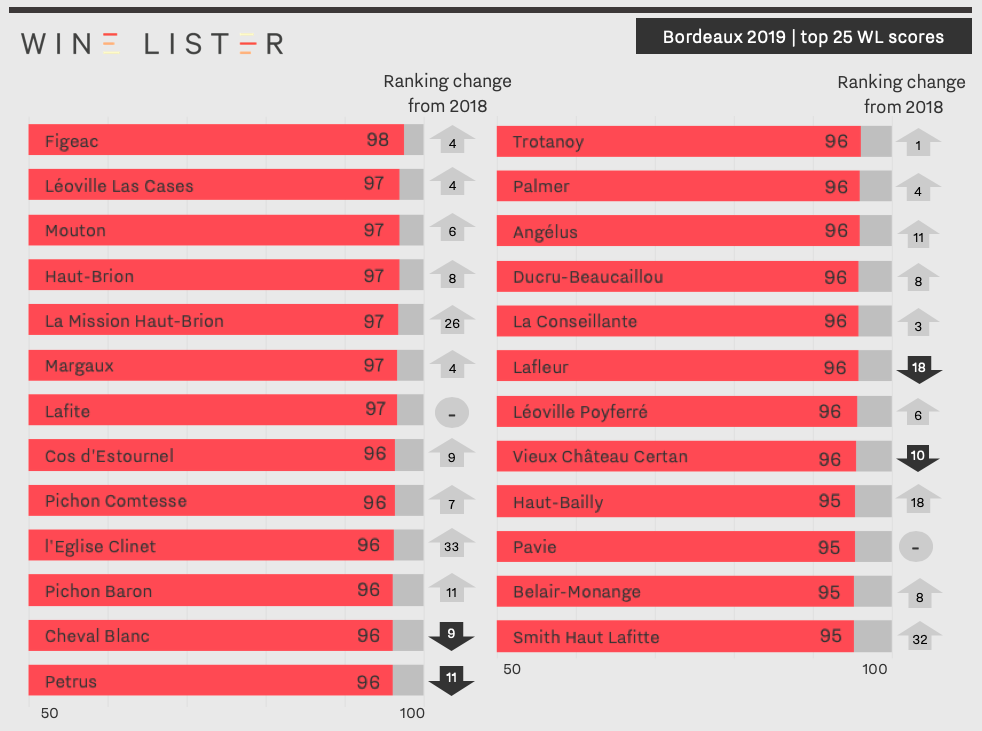
Consistent with last year’s ranking of Bordeaux 2018s by Quality score (conducted before the introduction of Wine Lister’s free site, featuring WL scores out of 100), Pomerol earns the highest number of places (six) in the top 25 2019s by WL score. Neighbouring Saint-Emilion follows closely behind with five spots in this year’s ranking, including the top-scoring wine of the vintage, Figeac 2019, which achieves a WL score of 98.
The four first growths to release their 2019s en primeur appear in third through seventh places, intersected by La Mission Haut-Brion’s entry at fifth place. This promising Pessac-Léognan climbs an impressive 26 spots in 2019, and, as mentioned in our previous blog, has been recently assigned MUST BUY status. Neal Martin scores La Mission Haut-Brion 2019 98-100 points, declaring: “I wager that ultimately this will become one of the wines of the vintage”, concluding that the wine is “breathtaking”.
L’Eglise Clinet sees an impressive upwards shift of 33 places this year, entering the top 10 with a WL score of 96. A poignant tribute to its late winemaker, Denis Durantou, its 2019 has received significant praise, with Antonio Galloni noting that it is “very clearly one of the wines of the year. A Pomerol of soaring, majestic intensity, L’Eglise-Clinet dazzles from start to finish”.
Pichon-Baron and Angélus both climb eleven places in this year’s top-25 ranking, to 11th and 16th place, respectively, with the former receiving top scores from both Neal Martin and Antonio Galloni. Both critics allude to the depth of Pichon-Baron’s 2019, with Galloni stating that “pomegranate, chocolate, licorice and spice are all lavishly expressed”. This represents one of Pauillac’s four entries on this year’s top-25 ranking, which also comprises Mouton, Lafite, and Pichon Comtesse.
Haut-Bailly makes a sizeable leap of 18 places since last year, ranking in 21st place with a WL score of 95. At £70 per bottle (in-bond) Haut-Bailly 2019 is also a Wine Lister MUST BUY. Fellow Pessac-Léognan producer, Smith Haut Lafitte, climbs an impressive 32 places with its 2019 vintage, rounding out the top 25 list. Having tasted twice, Neal Martin describes its “intense, very pure bouquet with blackberry, briary and cherry compote and a hint of black olive tapenade in the background”.
Also featured in the top 25 Bordeaux 2019s by WL score are: Belair-Monange, Cheval Blanc, Cos d’Estournel, Ducru-Beaucaillou, Haut-Brion, La Conseillante, Lafleur, Léoville Las Cases, Léoville Poyferré, Margaux, Palmer, Pavie, Petrus, Trotanoy, and Vieux Château Certan.
Wine Lister Pro members can read Part II of the Bordeaux study here. All free users can purchase the report for £125 from Wine Lister’s Analysis page (available in both English and French).
With the Bordeaux 2019 en primeur campaign now concluded, we bring you 38 new Wine Lister MUST BUYs. The tasting of Bordeaux 2019 has thus far confirmed the notable quality of the vintage, from which we have filtered some obvious campaign buys that can be expected to see increased prices, and decreased availability in the future.
Wine Lister’s MUST BUY recommendation algorithm takes into account a wine’s quality and value within its vintage and appellation, as well as the latest industry intelligence from key players in the global fine wine trade. These results are then filtered through an intelligence-based, human overlay, which identifies MUST BUY wines based on our tasting of Bordeaux 2019, and observation of the reception of each release in the market.
As illustrated below, there are 38 Bordeaux 2019s that are now recognised as MUST BUYs – suggesting that the benefit of buying en primeur is more obvious than last year (there were 24 Bordeaux 2018 en primeurs recognised as MUST BUYs following its campaign). They are all red:
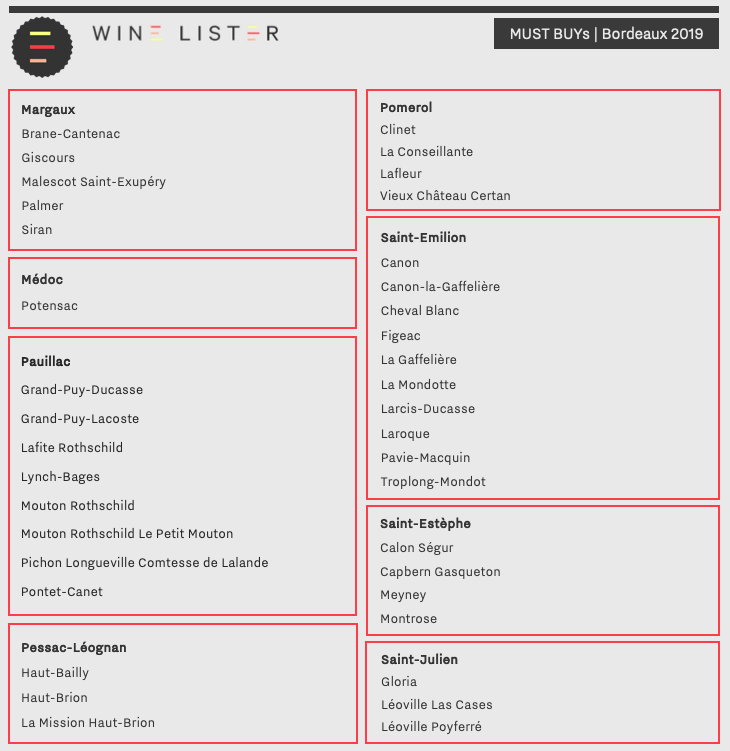
In keeping with last year’s MUST BUY picks, Saint-Emilion once again ranks as the most recommended appellation – this year offering 10 MUST BUYs, including the top-scoring wine of the vintage: Figeac 2019. With a WL score of 98, Figeac’s latest vintage has sustained the château’s upward quality trajectory.
With a WL score of 93 at £18 per bottle (in-bond), Laroque 2019 exhibits excellent value relative to 2019 Saint-Emilions of comparable quality. Alongside its MUST BUY status, Laroque’s latest vintage is also a Value Pick, making it an essential acquisition for the savvy Bordeaux buyer. Wine Lister partner critic, Antonio Galloni, notes, “raspberry jam, spice and red plum meld into the juicy finish”, stating that “the 2019 is very nicely done”.
Pauillac houses eight Bordeaux 2019 MUST BUYs, including first growths Lafite and Mouton, which both achieve WL scores of 97. Grand-Puy-Ducasse 2019 is both a MUST BUY and a Value Pick, having achieved a WL score of 93 at £23 per bottle (in-bond). Writing for Jancisrobinson.com, James Lawther muses whether the 2019 is the, “best of recent vintages?”, suggesting that it “certainly has more structure and power with additional mid-palate flesh”. As proposed in a previous Bordeaux 2019 en primeur blog, Pichon Comtesse is another notable Pauillac purchase for wine collectors, given the estate’s impressive popularity, and its vast reduction in volume released this year.
Within its five MUST BUY picks (four at under £50 per bottle in-bond), Margaux contains two Value Picks, with Malescot Saint-Exupery and Siran priced at £31 and £20 per bottle (in-bond), respectively. At £167 per bottle (in-bond) Palmer 2019 shows good value within the context of its previous vintages (31% below the 2018 and 2016 release prices), which, alongside its limited quantity released en primeur, makes this a must for Margaux enthusiasts.
In Pomerol, La Conseillante, Lafleur, and Vieux Château Certan achieve WL scores of 96, while Clinet follows shortly behind with 95. At £54 per bottle (in-bond) the latter is notably cheaper than its Pomerol peers, and has made a major leap up in quality from previous vintages. Awarding it 97-99 points, Neal Martin writes that Clinet 2019 “is just so fragrant on the nose”, stating that, “the purity that Ronan Laborde and his team have achieved should be applauded”.
Calon Ségur and Montrose lead Saint-Estèphe’s four MUST BUYs with a shared WL score of 95, while Meyney and Capbern provide testament to the value proposition available in the appellation, having been priced at £19 and £15 per bottle (in-bond), respectively.
Sharing three picks apiece are further left bank appellations Saint-Julien and Pessac-Léognan, which are both home to high-scoring 2019s. In Saint-Julien, Léoville Las Cases achieves a WL score of 97 – matched by Pessac-Léognan first growth Haut-Brion, and neighbour, La Mission.
Other wines featured in Wine Lister’s Bordeaux 2019 MUST BUYs are: Brane-Cantenac, Canon, Canon-la-Gaffelière, Cheval Blanc, Giscours, Gloria, Grand-Puy-Lacoste, Haut-Bailly, Le Petit Mouton, La Gaffelière, La Mondotte, Larcis-Ducasse, Léoville Poyferré, Lynch-Bages, Pavie-Macquin, Pontet-Canet, Potensac, and Troplong-Mondot.
Wine Lister has now released Part II of its annual in-depth Bordeaux Study, examining the price and quality of Bordeaux 2019, relative to previous vintages. Purchase the full report here, or download using your Pro subscription (available in both English and French).
Despite wide speculation over whether an en primeur campaign could proceed at all in 2020, this year’s campaign is now more or less complete, and Wine Lister’s scores are in. Bordeaux 2019s exhibit high quality across the board, receiving frequent comparison with recent great vintages – 2016, 2015, 2010, and 2009.
Wine Lister has now published its latest Wine Leagues on the new vintage – examining which Bordeaux 2019s rank best for WL score in each major appellation.
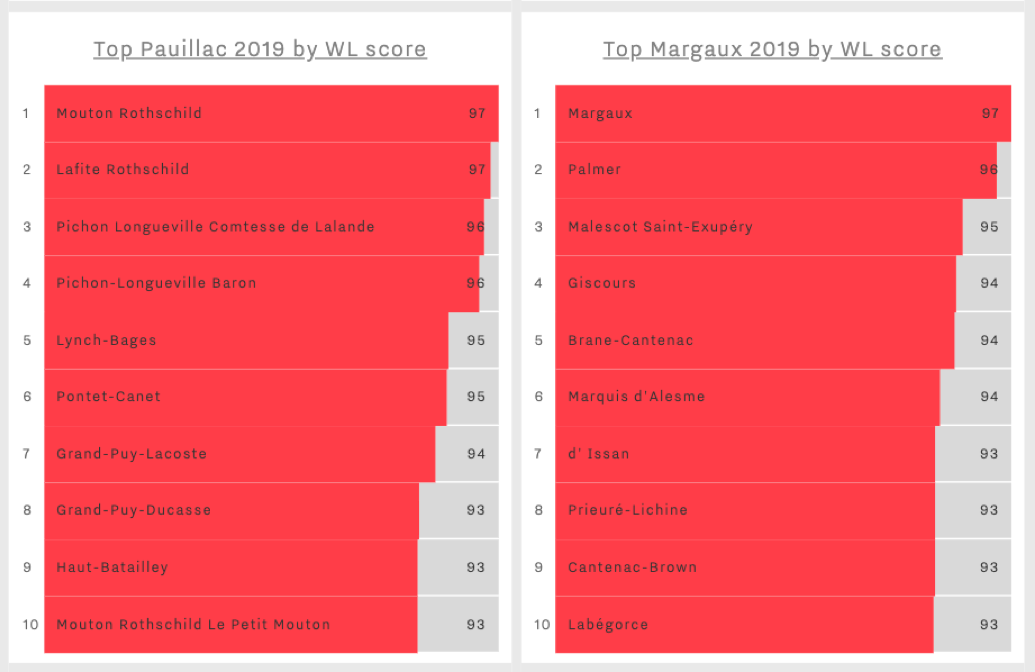
Pauillac First Growths, Lafite and Mouton, lead the appellation’s league of top 2019s by WL score, with a joint score of 97. Pichon Comtesse and Pichon Baron follow suit with 96 – the latter achieving its highest WL score since its 2016 vintage. Wine Lister partner critic Neal Martin describes Pichon-Baron 2019 as having “a very refined bouquet” and a “silky smooth, creamy texture”, stating it “retains all the classicism you could ask for”.
The league of Margaux 2019s by WL score is topped by the appellation’s namesake property, whose latest release joins fellow Pauillac Firsts with a score of 97. Following Palmer’s entry with 96, Malescot Saint-Exupéry 2019 achieves the château’s highest ever WL score (95). Wine Lister partner critic, Antonio Galloni notes that the 2019 is “a striking wine that is sure to find many admirers”, recounting an “interplay of earthy and savoury notes with rich, dense fruit… utterly captivating”.
There are four Value picks featured in the league of Margaux 2019s by WL score, with Labégorce, Malescot Saint-Exupéry, Marquis d’Alesme, and Prieuré-Lichine all achieving scores of 93 and above, at under £35 per bottle (in-bond).
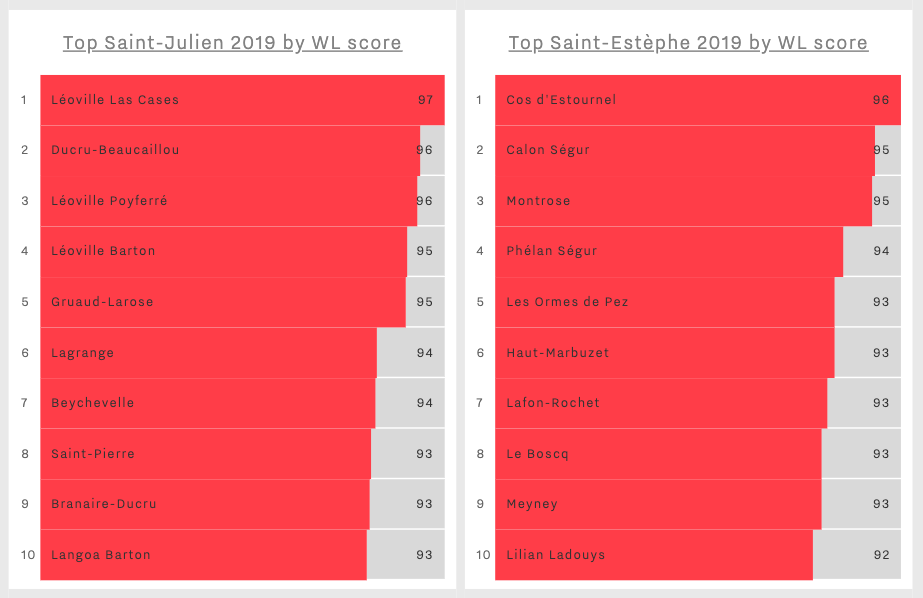
In Saint-Julien, Léoville Las Cases 2019 achieves a WL score of 97, matching that of its 2018 and 2016 vintages. Ducru-Beaucaillou and Léoville Poyferré appear in joint-second place with 96 – achieving their highest WL scores since 2016 and 2015, respectively. Ducru-Beaucaillou 2019 performed notably well at tastings, with Neal Martin, awarding it 96-98 points. He notes its “filigree tannins, pitch perfect acidity and a sensual, satin-like texture”, concluding that the wine is “outstanding in terms of persistence”.
With a score of 96, Cos d’Estournel 2019 tops the league for Saint-Estèphe 2019s by WL score, matching its successful 2018 and 2016 vintages. Writing for JancisRobinson.com, James Lawther describes the vintage as “powerful but carefully constructed and precise”, noting “a lovely mellow quality to such a muscular wine”. While both falling one WL score below their previous vintage, Calon Ségur and Montrose appear second in the appellation’s league, with a shared score of 95.
Branaire-Ducru 2019 and Meyney 2019 exhibit notable value within their appellations – both achieving WL scores of 93 at £29 and £19 per bottle (in-bond), respectively.
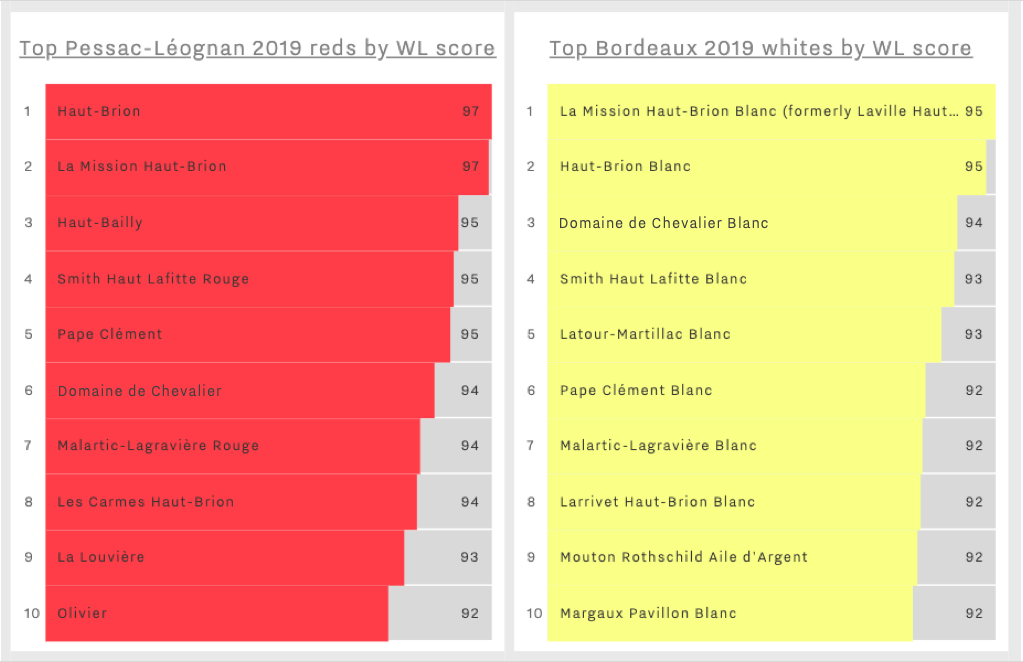
Haut-Brion and La Mission Haut-Brion perform notably well in 2019, achieving joint-first place in the league of top Pessac-Léognan 2019 reds by WL score. As examined in a previous Bordeaux 2019 en primeur blog, the en primeur darling, Les Carmes Haut-Brion, shows clear qualitative success in 2019, and its small production levels and smart en primeur pricing has once again made it a clear campaign buy. Another promising pick from Pessac-Léognan, Olivier 2019 achieves Value pick status at c.£20 per bottle (in-bond), and achieves the château’s highest WL score (92). Antonio Galloni recounts “smoke, licorice, cured meat, graphite and savory herbs infuse the 2019 with striking aromatic intensity to play off its sumptuous fruit”, concluding that the wine is “Very good”.
Haut-Brion and La Mission Haut-Brion attain joint-first place for their whites as well as reds in 2019, achieving scores of 95 in the league of top Bordeaux 2019 whites by WL score. Latour-Martillac Blanc 2019 achieves the highest WL score seen across its vintages (93) – one WL score above Pape Clément Blanc’s 92. At c.£21 per bottle (in bond) Latour-Martillac Blanc 2019 enters the market 10-30% below the current market prices of vintages 2016-2018, showing good value for its quality. Neal Martin notes on the latest vintage: “subtle tropical notes of pineapple and orange rind with hints of strawberry come through on the finish”.
On the right bank, the league of top 10 Saint-Emilion 2019s is crowned by Figeac’s high-scoring 2019. Up one point on its 2018, Figeac’s latest release achieves the highest WL score of all Bordeaux 2019s (98). Figeac 2019 illustrates the château’s impressive upward quality trajectory, which has seen its WL score slowly but surely increase from 91 in 2008. Neal Martin gives the latest vintage 97-99 points, describing it as “exquisitely defined… a deeply impressive, intellectual Figeac”.
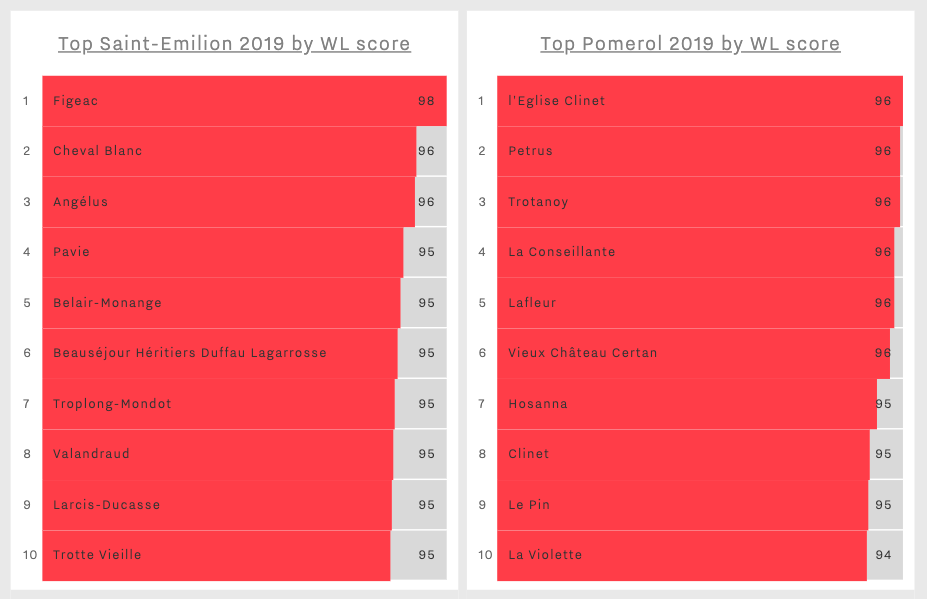
La Conseillante, Lafleur, l’Eglise Clinet, Petrus, Trotanoy, and Vieux Château Certan share the top WL score of Pomerol 2019s (96), separated by mere decimals. A release of note, l’Eglise Clinet 2019 is the last vintage of the late Denis Durantou, who sadly passed away in May. Neal Martin’s impressive score of 97-99 suggests the last vintage was his best, adding, “the perfect way to remember and raise a toast to one of Pomerol’s finest vignerons”.
Click here to view all Wine Leagues. Pro users have access to a more extensive set of Leagues and can log in to access here.
 Joseph Phelps’ Napa Valley vineyards – which saw their hottest recorded temperatures in 2017
Joseph Phelps’ Napa Valley vineyards – which saw their hottest recorded temperatures in 2017












